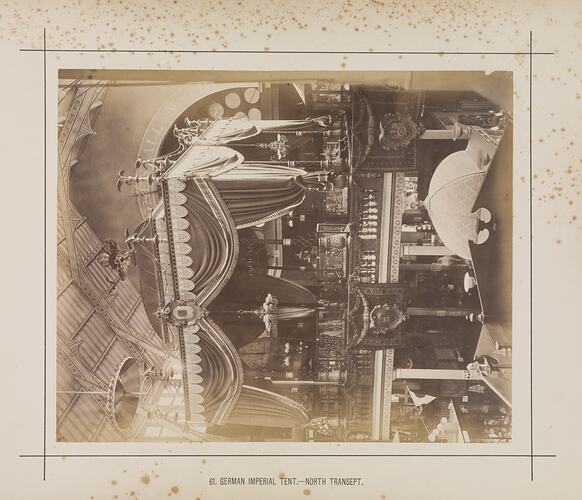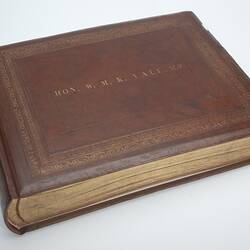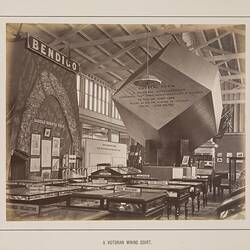Summary
View of the German Imperial Tent on the balcony of the north transept of the Great Hall of the permanent Exhibition Building at the 1880 Melbourne International Exhibition held at the Exhibition Buildings, Carlton Gardens, between 1 October 1880 and 30 April 1881.
In addition to the main permanent Exhibition Building, two permanent annexes as well as a large, central wooden temporary annexe was constructed to house the courts of various countries, or to include larger items from countries already represented in the main Building.
While the official plans for the exhibition show Germany having been allocated various court space in at least three different areas, the German commissioner would complain in a letter to Melbourne's press that lack of coordination between London and Australia in the early planning stages meant that German exhibits were spread across no less than eight locations around the exhibition buildings, one of these being the Imperial Tent in the north transept.
The Imperial Tent housed the German Court's displays of fine jewellery and was described as 'one of the most interesting portions of the Exhibition':
'Diamonds and emeralds of fine quality are conspicious in the gold sets, and there is one diamond of 10 carats. Various forms of bracelets are shown, and one of massive shape contains a single stone of great brilliance. The pendants are of many patterns, and amongst the most noticeable are some in the Renaissance style. As a rule, the diamonds are set in gold, but a fine effect is also obtained with combinations of diamonts and silver, of which an imitation of the Alphine flower, Edelweiss, is one of the best examples. Lockets set with diamonds, chased, or ornamented with wreaths and birds, with lustrous wings, are worthy of inspection.'
The German Court in the Great Hall was situated in the eastern nave in the far north-east corner, next to the British Court and opposite the courts of France and Italy on the oppossing southern wall of the nave. This portion of the German courts housed the fine Meissen procelain, clearly visible in this photograph.
This is one of sixty-one photographs in a presentation photograph album titled '1880 Melbourne International Exhibition' presented to Thomas B. Hill. Hill was the Assistant Secretary of the 1880 Melbourne International Exhibition. This leather bound album was given to Hill, and all the Exhibition Commissioners, by the Exhibition Trustees. The photographer is believed to be Ludovico Hart, acting on a private commission from the Exhibition Trustees.
Description of Content
International Exhibition at Exhibition Building, Melbourne, 1880: interior view showing the German Imperial tent in the northern transept.
Physical Description
Monochrome, gold-toned, silver gelatin photograph in a black leather bound album with decorative gold tooled border and gold tooled lettering in centre of front cover. Inside, 61 monochrome photographic plates showing exterior and interior views of the 1880 International Exhibition, held at the Royal Exhibition Building, Melbourne. Each photograph is mounted on heavy buff coloured card and has a simple black line border with a title beneath the photograph.
Significance
The Royal Exhibition Building has played an important role in Melbourne's social commercial and sporting life since it was built for the Melbourne International Exhibition in 1880. The building's size and scale provide us with a physical example of 'boom-time' Melbourne in 1880. The international exhibitions of the late 1800s provided the fledgling Australian colonies with a forum in which to showcase their progress in commerce and industry to the world. This album is significant for its detailed visual record of the first international exhibition held in Melbourne. It has clear views of the colonial & international courts, as well as specific prominent exhibits. It also provides a contemporary view of the Exhibition Building interior and exterior in the year it was constructed.
More Information
-
Collection Names
-
Collecting Areas
Images & Image Making, Public Life & Institutions, Royal Exhibition Building
-
Acquisition Information
Transfer from Trustees of the Royal Exhibition Building (REB), Sep 1991
-
Place & Date Depicted
1 Nicholson Street, Melbourne, Greater Melbourne, Victoria, Australia, 1880
-
Manufactured For
1 Nicholson Street, Melbourne, Greater Melbourne, Victoria, Australia, 1880
-
Photographer
Ludovico Hart, Melbourne, Greater Melbourne, Victoria, Australia, 1880
-
Presented To
Mr Thomas B. Hill - Melbourne Commission, 1880 Melbourne International Exhibition, Melbourne, Greater Melbourne, Victoria, Australia, 1880
-
Presented By
The Exhibition Trustees, Melbourne, Greater Melbourne, Victoria, Australia, 1880
-
Agent
Schmedes, Erbsloh & Company, Melbourne, Greater Melbourne, Victoria, Australia, 1880
-
Exhibitor
-
Format
Photograph, Monochrome
-
Inscriptions
Printed in black ink on card below the photograph: '61. GERMAN IMPERIAL TENT. - NORTH TRANSEPT.'
-
Classification
Public events, Melbourne international exhibition 1880, Photograph albums
-
Category
-
Discipline
-
Type of item
-
Image Dimensions - Photograph
236 mm (Width), 289 mm (Height)
Dimensions of photograph only
-
References
'The German Court at the Exhibition', Argus, 22 October 1880, p.7. 'Exhibition Notes', Argus, 15 February 1881, p.6. On Ludovico Hart see: The Aust'n Photographic Journal, March 20 1896, p.56.
-
Keywords
Buildings, Civic Mementoes, Exhibitions, Exhibitions: Melbourne International, 1880-1881, Jewellery, Keepsakes, Medal Presentations, Photography, Public Ceremonies, Royal Exhibition Building, Royal Exhibition Building Trustees, Royal Exhibition Building: History of Events, 1879-1899




